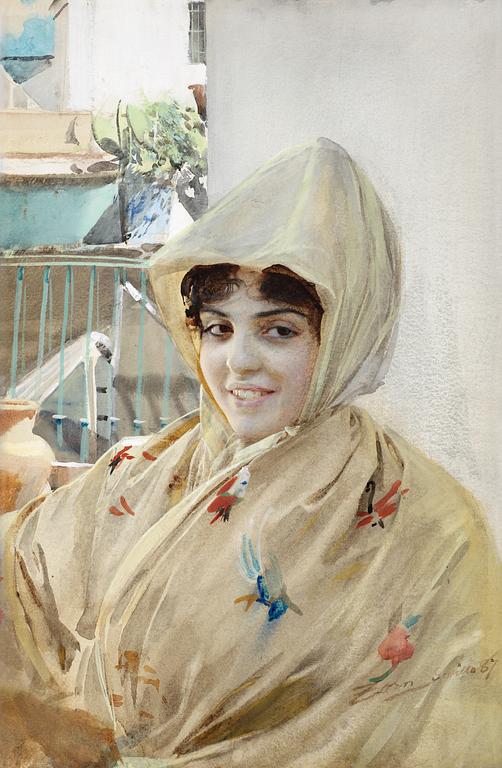Anders Zorn
"Mathilde" / "Spansk flicka i Sevilla (Matilda)"
Signed Zorn and dated Sevilla -87. Watercolour and gouache 49 x 32 cm.
Provenance
Earlier in the banker Fredrik Warburgs and his wife Emmas collection, London.
Agnes Warburg (daughter to the above).
John Philipson (Nephew to the above).
Thereafter inherited by the present owner.
Exhibitions
The Zorn museum, Mora, "Zorn i Spanien", 16 May - 13 September 2009.
The Zorn museum, Mora, "Zorns mästerverk", 13 May - 14 September 2010.
The museum Prins Eugens Waldemarsudde, Stockholm, "Zorns mästerverk", 23 October 2010 - 30 January 2011.
Literature
Ernst Malmberg, "Larsson-Liljefors-Zorn. En återblick", 1919, mentioned page 93.
Gerda Boëthius, "ZORN -Tecknaren, Målaren, Etsaren, Skulptören", 1949, mentioned page 226-227 and 229, in the catalogue list under the year 1887, page 542.
Anders Zorn, "Självbiografiska anteckningar" (published and commented by Hans Henrik Brummer), 1982, mentioned page 185 and 186.
Johan Cederlund, "Zorn i Spanien", 2009, mentioned page 85 and with picture in colour at page 87.
Johan Cederlund (red.), "Zorn. Mästerverk", 2010, described by Johan Cederlund Ph.D, page 52 and with picture in colour at page 53.
More information
-
Designer
Anders Zorn, born in Mora in 1860, showed artistic talent from a young age. In 1875, he traveled to Stockholm and became a student at the then Slöjdskolan (now Tekniska högskolan) in Stockholm, and shortly after, he joined the Royal Academy of Fine Arts. Initially, Zorn had aspirations of becoming a sculptor, but soon watercolor painting took over, becoming his primary medium until 1887. At the student exhibition in 1880, Zorn had his breakthrough with the watercolor painting "I sorg." The following year, he gained international acclaim as a portrait painter. His watercolor painting reached its pinnacle during this period, and his most famous work from this time is "Vårt dagliga bröd” from 1886. Shortly thereafter, Zorn transitioned to oil painting, which was met with immediate success. Zorn's reputation mainly rested on his portrait art, and he portrayed many notable figures, including presidents. For instance, he created an etching of Theodore Roosevelt. His etchings significantly contributed to his success. In the late 1880s, Zorn began working in the genre that would increasingly become his trademark: nude figures in outdoor settings. He had long been fascinated by the movement of water and the reflections of light on its surface. Now, he added the complexity of placing a model near or in the water, aiming to depict a synthesis between nature and humanity. In 1896, Zorn and his wife moved back to Sweden and settled in Zorngården in Mora. This move sparked a renewed interest in his homeland, which would be reflected in his future paintings. Among the artist's scenes from the Mora region, portraying its local customs and ancient traditions, "Midsommardansen" holds the highest value according to Zorn himself. Today, the painting can be found at the National Museum.
Read more






























